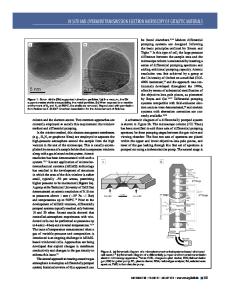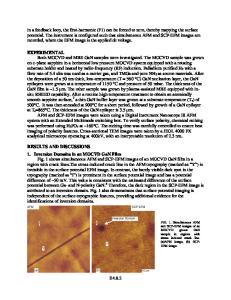In situ electron microscopy of ferroelectric domains
- PDF / 919,434 Bytes
- 9 Pages / 585 x 783 pts Page_size
- 7 Downloads / 405 Views
Introduction Since the discovery of BaTiO3 in the mid-1940s, ferroelectrics have attracted considerable interest in both theoretical work and device engineering.1–4 A ferroelectric is characterized by spontaneous polarization that can be reversed through the application of an external electric field, a behavior similar to the reorientation of ferromagnetic moments under an applied magnetic field. These switchable polarization states have been utilized in an important class of nonvolatile memories.1,5–7 The ferroelectric polarization also couples directly with electronic transport properties,6,8–13 surface chemistry,14 strain, and magnetic order15–18 and holds promise for myriad multifunctional devices. The switching of the spontaneous polarization occurs through the nucleation and growth of favorably oriented domains in a highly inhomogeneous process in which local variations in free energy caused by defects such as interfaces, dislocations, and oxygen vacancies dominate switching kinetics.19 The effects of defects would usually cause several deleterious phenomena in real ferroelectric devices, including a loss of switchable polarization after many switching cycles (fatigue),20–22 a preference of one polarization state over the opposite one under certain conditions (imprint/ aging),21,22 and a failure to retain its stored polarization (retention failure).23–31 A fundamental understanding of the role of defects is thus necessary to engineer ferroelectric devices.
Additionally, the continuing trend toward miniaturization of electronic components necessitates an understanding of domain dynamics in ferroelectric systems on nanometer scales, where a single defect might dominate the polarization switching process, and a statistical treatment is not applicable. Many techniques have been used to study domain switching behavior in ferroelectric materials, such as x-ray diffraction,32 polarized light microscopy,33,34 time-resolved photoemission electron microscopy,35 and piezoresponse force microscopy.2,36–38 Recent advances in in situ transmission electron microscopy (TEM), however, enable the direct observation of domain switching with simultaneously high spatial (
Data Loading...











